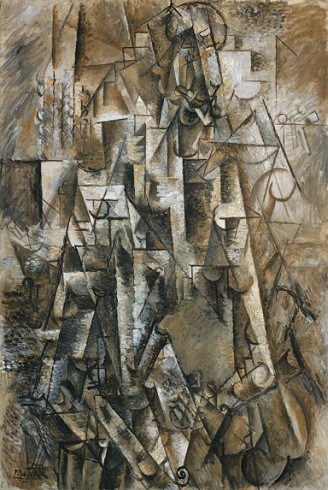All AP Art History Resources
Example Questions
Example Question #1 : Understanding Terminology That Describes Twentieth And Twenty First Century 2 D Art
Screen printing is an artistic method that allows for __________.
transforms the brushstrokes in a painting into different shapes
transforms the colors on a canvas painting
reproduction of an image on different pieces of art
projects an image onto a canvas to allow for hand copying
reproduction of an image on different pieces of art
The technique of screen printing involves taking a stamp, covering it with cotton mesh, and inking the stamp onto a canvas to produce an exact image from the stamp. The technique, first developed in the early twentieth century, allows an artist to reproduce the same image repetitively on different pieces of art. This ability was used by Pop Artists like Andy Warhol to create similar images onto canvases which he then painted in a variety of colors to make similar, yet highly diverse, series of images.
Example Question #1 : Understanding Terminology That Describes Twentieth And Twenty First Century 2 D Art
Surrealism is the style most closely associated with which of the following artists?
Henri Matisse
Pablo Picasso
Salvador Dalí
Amedeo Modigliani
Salvador Dalí
Surrealism was inspired by the work of pioneering psychologists like Sigmund Freud and Carl Jung, and used odd, dreamlike imagery in realistic lines and shapes. Its most famous figure was Salvador Dalí, who was the archetypical surrealist. Dali's painting often featured familiar images juxtaposed with strange objects in barren and off-putting landscapes.
Example Question #11 : Twentieth And Twenty First Century 2 D Art
The American painter Grant Wood is most closely associated with the artistic movement known as __________.
neo-classicalism
abstract expressionism
regionalism
pop art
regionalism
Grant Wood lived almost his entire life in the state of Iowa, teaching at schools and supporting organizations in the state. His painting reflected this attachment to his native region, and were articulated by Wood, along with Thomas Hart Benton, into an artistic style known as "regionalism." Wood's most famous work "American Gothic," featuring a farming couple in an honest, empathetic, yet slightly off perspective, is emblematic of the style.
Example Question #351 : 2 D Art
Each of these paintings are deconstructions of __________.
panoramas
landscapes
still lifes
portraits
portraits
Cubism, the style of art both these paintings fall under, sought to reimagine and redefine art by exploring geometric shapes and mathematical concepts. In order to reimagine the very concept of painting, cubists approached traditional styles of art in new ways. Each of these paintings is a portrait, deconstructed. The painting on the left is of a poet, (Le Poéte) by Pablo Picasso. The painting on the right is a portrait of Picasso by Juan Gris.
Figure 1: Le Poéte by Pablo Picasso (1911)
Figure 2: Portrait of Pablo Picasso by Juan Gris (1912)
Example Question #2 : Understanding Terminology That Describes Twentieth And Twenty First Century 2 D Art
Color in photographs is primarily determined by mixing the three base colors of __________.
red, blue, and green
black, green, and blue
red, blue, and yellow
red, white, and black
red, blue, and green
A color photographic negative is still black and white, and the color is only brought to the photograph in the development process. Layers of red, green, and blue all filter into particular shades of gray to determine color in traditional color photography. Thus, a photographer can imbue the photo in slightly different ways by developing a photograph in a particular manner.
Example Question #3 : Understanding Terminology That Describes Twentieth And Twenty First Century 2 D Art
"Photorealism" is a term most associated with which of the following artists?
Cindy Sherman
Andy Warhol
Robert Rauschenburg
Chuck Close
Chuck Close
Chuck Close's painting method begins with photographs, typically portraits, which he then copies onto huge, wall-size canvases. Close's intial works in the late 1960s and 1970s were extremely realistic, looking like photographs from across a room. As Close kept changing his method, he still worked from photographs, but would add more abstract painting methods to produce his images.
Example Question #1 : Understanding Terminology That Describes Twentieth And Twenty First Century 2 D Art
"Drip painting" is the approach to painting in which __________.
large blocks of color are painted across the canvas
paint is allowed to fall on the canvas from a vertical position
a glossy finish is applied at the end of the painting to give the work a wet look
the paint is applied so thickly as to give a three-dimensional effect
paint is allowed to fall on the canvas from a vertical position
Drip painting is most closely associated with the twentieth-century American painter Jackson Pollock, whose signature works involved Pollock splattering, splashing, and slowly dripping paint directly onto canvasses that were laid on the ground. The technique was used almost contemporaneously by the artist Janet Sobel, and has been consistently used by a small cadre of artists from the 1950s to the present.
Example Question #4 : Understanding Terminology That Describes Twentieth And Twenty First Century 2 D Art
The "Zone System," formalized by photographer Ansel Adams in the early twentieth century, established __________.
the theory for the use of photography instead of painting
the formulation for use in balancing the color in a color photograph
the principles for developing film to achieve optimal light and focus in a photograph
the proper method for framing a photograph before taking the image
the principles for developing film to achieve optimal light and focus in a photograph
Ansel Adams is well known for two related things: his sweeping black and white photographs of the American West and his many books and classes teaching photography. Most significant in relation to the latter is his development of the "Zone System." The Zone System set down specific parameters to achieve the optimal light, focus, and composition in the development of the film.
Example Question #351 : 2 D Art
The loosely defined group of painters known as the "Ashcan School" were largely united in their use of __________.
pop culture phenomena
themes from classical mythology
realistic street scenes
dramatic historical episodes
realistic street scenes
The "Ashcan School" referred to a loosely connected group of artists in the early twentieth century in Philadelphia and New York. John Sloan, Everett Henri, and George Luks were among the prominent artists associated with the movement. The movement, while fairly loosely associated, was largely united through a devotion to presenting scenes of urban life in a gritty, realistic manner.
Example Question #353 : Ap Art History
Which of the following techniques was used by Andy Warhol to create the multiple images making up his Marilyn Diptych?
Silk-screening
Mimeographing
Woodcut
Etching
Silk-screening
The Marilyn Diptych was created shortly after Marilyn Monroe's death in 1962. In order to create the work, Andy Warhol used only one publicity still of the actress, and repeated the image fifty times. Warhol used silk-screening, a process where a wooden stencil pushes ink-covered mesh onto a medium, to repeat the image. The left side of the diptych is painted over in bright, pastel colors, while the right side features only black and white images of the actress.
Certified Tutor
All AP Art History Resources





